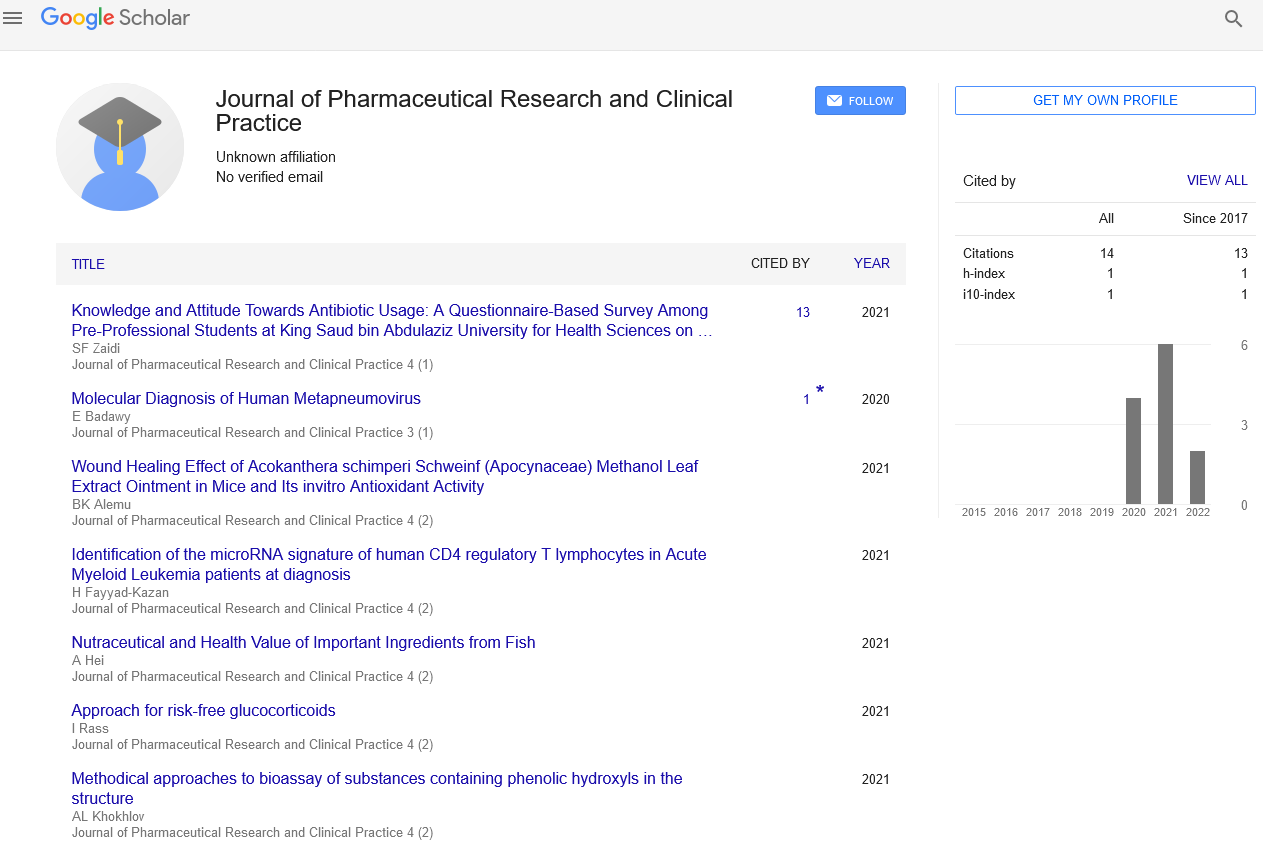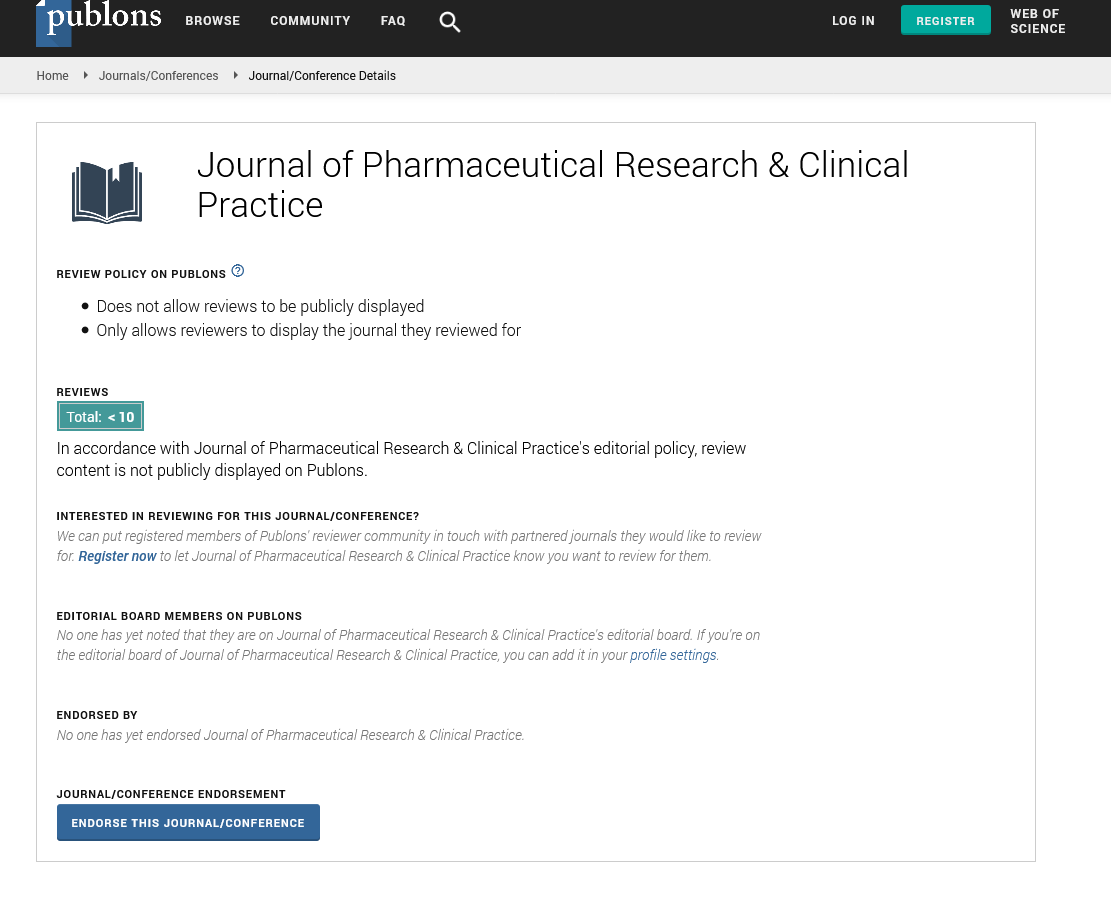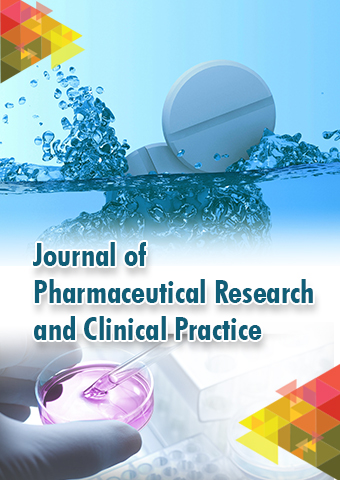Editorial - Journal of Pharmaceutical Research and Clinical Practice (2023) Volume 6, Issue 3
Ensuring Drug Safety: Protecting Lives and Enhancing Public Health
Kiran Nayak*
Department of clinical practice, India
Department of clinical practice, India
E-mail: nayak_kiran143@gmail.com
Received: 02-June-2023, Manuscript No. jprcp-23-103117; Editor assigned: 05-Jun-2023, PreQC No. jprcp-23- 103117(PQ); Reviewed: 19-Jun- 2023, QC No. jprcp-23-103117; Revised: 23-Jun-2023, Manuscript No. jprcp-23-103117 (R); Published: 30-Jun-2023; DOI: 10.37532/ jprcp.2023.6(3).50-53
Abstract
Drug safety is a crucial aspect of public health, aiming to minimize the risks associated with pharmaceutical products while maximizing their therapeutic benefits. This article provides an overview of the significance of drug safety and its impact on protecting lives and enhancing public health. It explores the processes involved in ensuring drug safety, including the drug development process, safety assessment, and post-marketing surveillance through Pharmacovigilance. The role of adverse drug reaction monitoring and risk communication is highlighted, emphasizing the importance of timely detection and assessment of adverse effects. Furthermore, the article discusses the evolving landscape of drug safety in the digital age, with the integration of technology and data analysis to complement traditional Pharmacovigilance systems. Overall, ensuring drug safety is vital in instilling confidence in patients, promoting adherence to treatment regimens, and reducing the burden of drug-related illnesses and fatalities, ultimately improving public health outcomes.
Keywords
Drug safety • Public health • Medication risks • Pharmacovigilance • Adverse drug reactions
Introduction
The safety of pharmaceutical drugs is a critical component of public health, aiming to protect lives and improve overall well-being. The field of drug safety encompasses a comprehensive range of measures and regulations that are designed to identify and minimize the risks associated with medication use, while maximizing their therapeutic benefits [1]. It involves the collaboration of various stakeholders, including regulatory authorities, pharmaceutical companies, healthcare professionals, and patients. Through stringent processes and vigilant monitoring, drug safety efforts strive to ensure that the benefits of medications outweigh the potential risks, ultimately enhancing public health outcomes. The importance of drug safety cannot be overstated. Each year, countless lives are saved and improved through the use of pharmaceutical interventions [2]. Medications have revolutionized healthcare by effectively treating diseases, alleviating symptoms, and preventing complications. However, no drug is entirely without risk. Even when prescribed and used appropriately, medications can cause unintended side effects and adverse reactions. Drug safety endeavours to identify, understand, and mitigate these risks, promoting the responsible and effective use of pharmaceutical products. Ensuring drug safety begins with the extensive process of drug development and evaluation. Before a drug reaches the market, it undergoes rigorous preclinical studies and clinical trials [3]. Preclinical studies involve laboratory and animal experiments to assess the drug’s potential efficacy and safety profile. If promising results are obtained, the drug progresses to clinical trials, which are conducted in phases involving human subjects. These trials aim to evaluate the drug’s safety and effectiveness, considering factors such as dosage, administration routes, and potential interactions with other medications. Regulatory authorities, such as the U.S. Food and Drug Administration (FDA) and the European Medicines Agency (EMA), play a pivotal role in the evaluation and approval of medications [4]. They meticulously review the data generated from clinical trials, carefully weighing the benefits and risks of the drug. Based on the benefit-to-risk assessment, regulatory authorities make informed decisions regarding drug approvals, label warnings, and restrictions to ensure patient safety. However, drug safety efforts do not end with the approval of a medication [5]. Once a drug is on the market, it enters a phase of post-marketing surveillance, where its safety profile is continuously monitored. This surveillance is primarily achieved through Pharmacovigilance, which involves the detection, assessment, understanding, and prevention of adverse effects or any other drugrelated problems. Healthcare professionals, patients, and pharmaceutical companies all play essential roles in reporting adverse drug reactions (ADRs) to regulatory authorities. These reports provide valuable insights into the safety of medications, enabling ongoing assessment and identification of potential risks. Furthermore, effective risk communication is crucial in ensuring drug safety [6]. Healthcare providers need accurate and up-to-date information about the potential risks associated with specific drugs to make informed decisions when prescribing medications. Similarly, patients must be wellinformed about the potential side effects and risks of the medications they are prescribed, empowering them to actively participate in their own healthcare decisions [7]. Transparent and comprehensive risk communication facilitates shared decision-making and encourages adherence to treatment regimens. In the digital age, the landscape of drug safety is evolving. Social media platforms and online forums have become valuable sources of information, enabling patients to share their experiences and report potential ADRs. The integration of technology and data analysis holds promise in complementing traditional Pharmacovigilance systems, facilitating the timely detection of emerging risks and improving drug safety surveillance.
Material and Methods
The significance of drug safety
Drug safety is essential to safeguarding public health. Each year, countless lives are saved and improved through the use of pharmaceutical interventions. However, every drug carries inherent risks, ranging from mild side effects to severe adverse reactions [8]. Drug safety efforts aim to identify and minimize these risks to protect patients and enhance the overall benefitto- risk ratio of medications. By ensuring the safety of drugs, healthcare systems can in still confidence in patients, promote adherence to treatment regimens, and reduce the burden of drug-related illnesses and fatalities.
The drug development process and safety assessment
Before a drug reaches the market, it undergoes a rigorous process of development and evaluation.
Preclinical studies involving laboratory and animal experiments assess the drug’s potential efficacy and safety. If the results are promising, the drug progresses to clinical trials, which are conducted in phases to evaluate its safety and efficacy in humans. These trials involve carefully selected populations and rigorous monitoring to identify any adverse effects [9]. Regulatory authorities, such as the U.S. Food and Drug Administration (FDA) and the European Medicines Agency (EMA), review the trial data and make informed decisions regarding drug approvals based on the benefit-to-risk assessment.
Pharmacovigilance: monitoring drug safety
Pharmacovigilance is the science and activities related to the detection, assessment, understanding, and prevention of adverse effects or any other drug-related problems. It plays a vital role in post-marketing surveillance to monitor the safety of approved drugs once they are available to the general population. Healthcare professionals, patients, and pharmaceutical companies contribute to Pharmacovigilance through reporting adverse drug reactions (ADRs) to regulatory authorities [10]. These reports enable the continuous assessment of drug safety profiles, identification of emerging risks, and implementation of appropriate risk minimization measures, such as labeling changes, dose adjustments, or even drug withdrawals if necessary.
Adverse drug reactions and risk communication
Adverse drug reactions (ADRs) are unintended and harmful effects caused by the normal use of a medication. They can range from mild reactions, such as nausea or dizziness, to severe or life-threatening events. Timely detection and assessment of ADRs are critical in preventing harm and ensuring drug safety. Regulatory authorities collaborate with healthcare professionals, pharmaceutical companies, and patients to collect and analyze ADR reports. Effective risk communication is crucial in disseminating information about potential risks associated with specific drugs to healthcare providers and patients, enabling informed decision-making and minimizing potential harm.
Ensuring drug safety in the digital age
With the rapid advancements in technology and the increasing availability of health information online, the landscape of drug safety is evolving. Social media platforms and online forums have become spaces where patients share their experiences and report potential ADRs. Pharmaceutical companies and regulatory authorities are exploring innovative approaches, such as data mining of social media posts, to complement traditional pharmacovigilance systems. These emerging methods hold the potential to improve the detection of previously unknown adverse effects, thereby enhancing drug safety surveillance.
Discussion
Drug safety plays a pivotal role in protecting the lives and well-being of individuals worldwide. It encompasses a comprehensive set of measures and regulations designed to minimize the risks associated with pharmaceutical products while maximizing their therapeutic benefits. The field of drug safety involves various stakeholders, including regulatory authorities, pharmaceutical companies, healthcare professionals, and patients. This article explores the importance of drug safety, the processes involved in ensuring it, and the evolving landscape of Pharmacovigilance in the pursuit of public health. Drug safety is of paramount importance in safeguarding public health. It involves a comprehensive approach, from the early stages of drug development to post-marketing surveillance. Through robust Pharmacovigilance systems and collaborative efforts among regulatory authorities, healthcare professionals, pharmaceutical companies, and patients, potential risks associated with medications can Drug safety is of paramount importance in safeguarding public health. It involves a comprehensive approach, from the early stages of drug development to postmarketing surveillance. Through robust Pharmacovigilance systems and collaborative efforts among regulatory authorities, healthcare professionals, pharmaceutical companies, and patients, potential risks associated with medications can be identified, minimized, and effectively communicated. As the field continues to evolve, embracing technological advancements and harnessing the power of data will further enhance drug safety efforts, ensuring the wellbeing of individual’s worldwide and advancing public health. Be identified, minimized, and effectively communicated. As the field continues to evolve, embracing technological advancements and harnessing the power of data will further enhance drug safety efforts, ensuring the wellbeing of individual’s worldwide and advancing public health.
Conclusion
Ensuring drug safety is paramount in protecting lives and enhancing public health. Through rigorous processes and vigilant monitoring, the risks associated with medication use can be identified, mitigated, and effectively communicated. Drug development, clinical trials, and regulatory assessments form the foundation of drug safety efforts, ensuring that medications meet rigorous standards of efficacy and safety before reaching the market. Post-marketing surveillance, facilitated by Pharmacovigilance systems, plays a crucial role in continuously monitoring the safety of approved drugs. The reporting of adverse drug reactions by healthcare professionals and patients enables the identification of emerging risks and the implementation of necessary risk minimization measures. Transparent and comprehensive risk communication to healthcare providers and patients fosters informed decision-making and promotes adherence to treatment regimens. The landscape of drug safety is evolving with the integration of technology and data analysis. Social media and online platforms provide opportunities for patients to share their experiences and contribute to Pharmacovigilance efforts. Harnessing the power of technology enhances the detection of previously unknown adverse effects, complementing traditional surveillance systems and improving drug safety surveillance. By prioritizing drug safety, healthcare systems can in still confidence in patients, leading to improved treatment adherence and better health outcomes. The reduction of drugrelated illnesses and fatalities becomes achievable through proactive risk management strategies, ensuring that the benefits of medications outweigh the potential risks. Ultimately, ensuring drug safety is a vital component of protecting lives, promoting public health, and advancing the overall well-being of individuals and communities. Ensuring drug safety is a vital aspect of protecting lives and enhancing public health. It involves a comprehensive approach that spans the entire lifecycle of a medication, from preclinical development to post-marketing surveillance. By identifying and minimizing the risks associated with pharmaceutical products, drug safety efforts in still confidence in patients, promote responsible medication use, and reduce the burden of drug-related illnesses and fatalities. The evolving landscape of drug safety, coupled with the integration of technology, further augments the ability to protect the public and optimize health outcomes.
References
- Panda VS, Naik SR.Cardioprotective activity of Ginkgo biloba phytosomes in isoproterenol-induced myocardial necrosis in rats: A biochemical and histoarchitectural evaluation. ExpToxicol Pathol. 60, 397–404(2008).
- Mazzotti A, Caletti MT, Sasdelli ASet al.Pathophysiology of nonalcoholicfatty liverdisease. Lifestyle gutgeneinteraction.Dig Dis. 34, 3–10 (2016).
- Kaski JP, Syrris P, Burch Met al.Idiopathic restrictivecardiomyopathyin children is caused bymutationsin cardiac sarcomere protein genes.Heart. 94, 1478–1484 (2008).
- Kotronen A, Westerbacka J, Bergholm Ret al.Liver fat in the metabolic syndrome.J Clin Endocrinol Metab. 92, 3490–3497 (2007).
- Mogensen J, Kubo T, Duque Met al.Idiopathic restrictivecardiomyopathyis part of the clinical expression of cardiac troponin I mutations.J Clin Invest. 111, 209–216 (2003).
- Kwanten WJ.Role of autophagy in the pathophysiology of nonalcoholicfatty liverdisease: a controversial issue.World J Gastroenterol. 20, 7325 (2014).
- Xing Y, Ichida F, Matsuoka Tet al.Genetic analysis in patients with left ventricular noncompaction and evidence for genetic heterogeneity.Mol Genet Metab. 88, 71–77 (2006).
- Faraji Hormozi S, Saeedi AA, Aminianfar Met al.Studying the Frequency of NosocomialInfectionand its Relative Factors in the Intensive Care Unit of Hospitals Based Upon NNI System.Eurasian J Anal Chem. 13, (2018).
- Dellefave LM, Pytel P, Mewborn S et al.Sarcomeremutationsincardiomyopathywith left ventricular hypertrabeculation.Circ Cardiovasc Genet. 2, 442–449 (2009).
- Morita H, Rehm HL, Menesses Aet al.Shared genetic causes of cardiac hypertrophy in children and adults.N Engl J Med. 358, 1899–1908 (2008).
Indexed at, Google Scholar, Crossref
Indexed at, Google Scholar, Crossref
Indexed at, Google Scholar, Crossref
Indexed at, Google Scholar, Crossref
Indexed at, Google Scholar, Crossref
Indexed at, Google Scholar, Crossref
Indexed at, Google Scholar, Crossref
Indexed at, Google Scholar, Crossref
Indexed at, Google Scholar, Crossref


